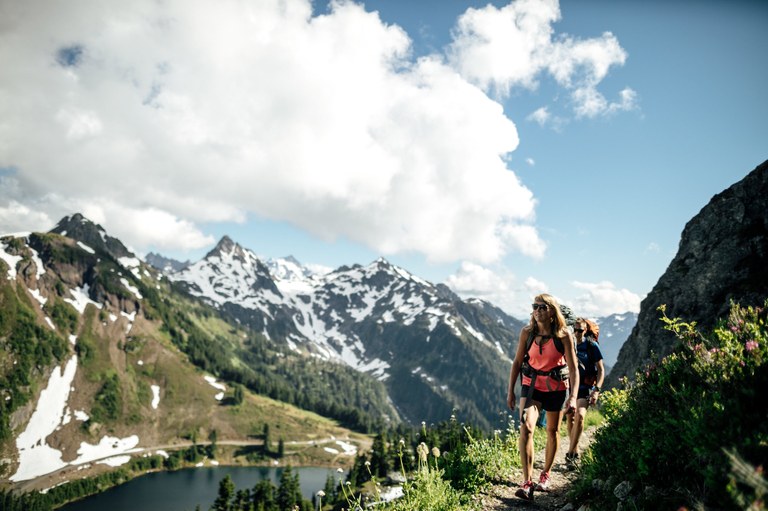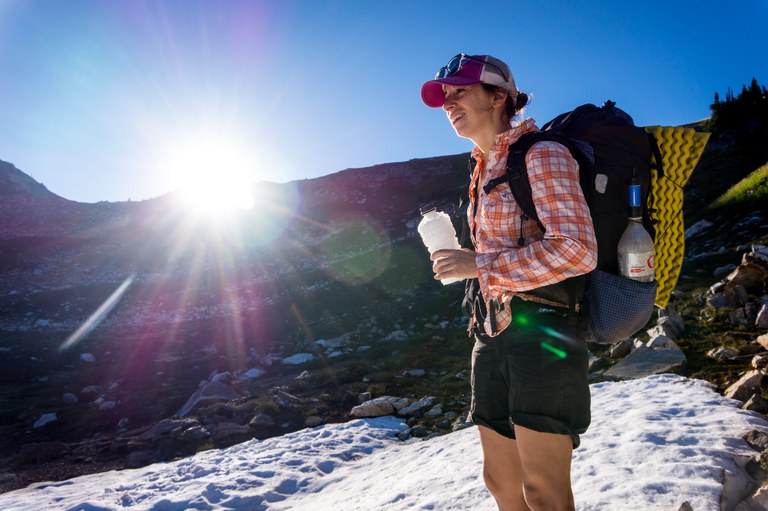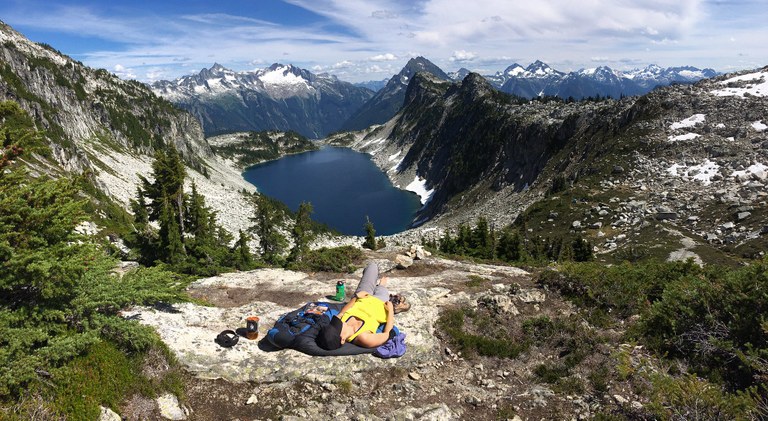Summer, Sun and Sweat: A Guide to Keeping it Cool
The Pacific Northwest’s summer climate is changing. Data indicates we are in for hotter summers every year, melting Washingtonian trail users’ perceptions of “good” hiking weather. Adventuring outdoors in the summer means paying even more attention to hiking basics like adequate hydration, proper layering and on-trail first aid (how do you treat a sunburn in the backcountry)? Peruse our collection of time-tested tips for beating the heat and staying safe while hiking in the height of summer.

Summer in the Pacific Northwest — the only season you'll need shades. Photo by Joseph Tobiason.
How Hot is Too Hot?
Kids, dogs (especially short-nosed breeds) and older hikers are more vulnerable to heat. So if the forecast calls for temperatures above 80 degrees, take a beat and really consider the conditions you'll be hiking in. Will there be sustained shade and water along the entire length of the trail? Will a child be able to cool off sufficiently in a carrier?
Knowing when to hike is a key skill. Wake up extra early to hit the trail — that way you can do the bulk of your hiking before the heat of the day hits. Catching sunrise, or getting 10 miles by 10 a.m., are great practices. Alpine starts provide more solitude and cooler temperatures than sleeping in. If possible, siesta by taking a nap in a cool, shady spot until the temperature cools off. Optimal siesta hours are 1–6 p.m, and are particularly handy during the summer, when there’s ample light for hiking in both the morning and the evening. Look for a shady or seaside hike. Perhaps you want to leave your pup at home for this one.
Research how much shade is available on trail and the highest and lowest elevations on your trip (every 1,000 feet of elevation gain equals 3.5–5 degrees F cooler). Familiarize yourself with dehydration, heat sickness and sunburn, and learn how to treat them.
Even if you’re a Northwesterner, when it’s hot out, take a page out of the Southwest’s book and keep cool!
Stay hydrated
You've heard it before, but it bears repeating — the number one way to stay healthy in the outdoors is to make sure you're getting plenty of fluids (and that means drinking water before, during and after your hike) and balancing hydration with salts.
You lose vital electrolytes when you sweat. Pack salty snacks for your trip. Items like salted nuts, pretzels, electrolyte mixes and goo are optimal when temperatures skyrocket. Ambitious hikers can pack a thermos at home full of ice and their favorite beverage.
Drink water whenever you feel thirsty, and make sure you are carrying enough to make it to your next water source. This is even more important as the temperature rises. Check out our other hydration-savvy tips.
Take any opportunity you can to hydrate. If it’s really hot, and if Leave No Trace conditions permit, dunk yourself in a body of water to cool off. If you can’t fully submerge, fill your water bottle and pour it over your body and clothes. Throwing on a wet shirt might feel frigid initially, but you’ll be thankful for it once you’re back under the sun.
WTA Pro Tip: Your four-legged friend needs water, too! Make sure pups drink whenever you do — they're more prone to dehydration and heat exhaustion than we are.

Make sure everyone in your hiking group is staying properly hydrated! Photo by David Auyong.
Lighten your layers
Hot-weather hiking means loose-fitting, lightly-colored synthetic fabrics that will wick moisture and keep you cooler as you move. As counter-intuitive as it may seem, long pants and long-sleeved shirts with hoods can help keep you cool by keeping off the sun, which will prevent sunburn and keep internal temperature more regulated. You can always wet down clothes to cool off. And don't forget your hat!
It’s best to avoid cotton in wet months due to the fabric’s moisture retention. In hot weather, however, moisture retention is exactly what you want. Cotton shirts will keep sweat close to your body for longer, making them perfect for days under the blazing sun. Some hikers also swear by lightweight merino wool. Whatever you choose, ensure it’s loose, breathable,light colored and has long sleeves.
WTA Pro Tip: Little ones may need a slightly different layering system than their grown-up companions. Read about how to keep kids comfy on trail.
Sunscreen 101
It's one of the 10 essentials and is extra important when hiking on reflective snow or sand — or at elevations above 5,000 feet, where the sun's rays are more intense. The American Academy of Dermatology recommends using a water-resistant, broad-spectrum sunscreen — which protects against both UVA (aging rays) and UVB (burning rays) — with a rating of SPF 30 or higher.
- Apply sunscreen 15 minutes before going outside.
- Use enough sunscreen to cover all exposed areas of skin; most adults need about one ounce (or one shot-glass full) of sunscreen to fully cover their body.
- Don't forget to cover lips, tops of feet and tips of ears with sunscreen, too.
- Reapply every two hours, or after swimming or sweating.
Wear light-colored hiking pants and accept they’re gonna show dirt. Protect yourself from the sun with head wear, sunglasses, sunscreen and even a sun umbrella. Neck gaiters, bandanas, shirts with lightweight fabric and long hair can also protect your ears and neck.
WTA Pro Tip: Sunglasses are a must for protecting sensitive eyes. Opt for a polarized pair if you're concerned about the glare on snow or water.

Snow, sand, water and hiking at higher elevations make sunglasses, sunscreen and hydration all the more important. Photo by Craig Peterson.
Know what heat exhaustion feels like
Heat exhaustion — often characterized by sudden general confusion, fatigue, possible headache or muscle cramps, pale skin, profuse sweating and a rapid heartbeat — can lead to heat stroke, a possibly fatal condition, if left untreated. As scary as that sounds, heat exhaustion is easily preventable with some common-sense approaches for planning your summer hikes:
Pay attention to the heat index. When temperatures rise to 90 degrees or higher, the risk of heat-related illnesses increases dramatically. Skip the exposed hill climb and opt instead for a shade-filled ramble in the woods.
Again with the hydration. Down some H2O (about 20 ounces) a few hours before you hit the trail and replenish frequently during your hike.
Add in electrolytes. Dehydration can result in salt depletion, a mineral necessary for proper body function. Replace some water with a sports drink or coconut water to replenish this vital nutrient.
Choose your layers carefully and don't forget the sunscreen.
WTA Pro Tip: If you find yourself or a hiking companion exhibiting signs of heat exhaustion, rest immediately, in shade if possible.
- Remove packs and any constricting clothing.
- Dampen a handkerchief with water and use it as a cooling compress on the neck and face.
- Drink water and replenish electrolytes.
- When resuming your hike, move slowly and rest as often as needed.

Find a place to rest and relax if you're feeling the heat while hiking. Photo by Cory Egan.
- Want more tips on summer hiking? Check out our guide for all things summer-adventure-related.
- Need inspiration for where to hike or backpack for what remains of summer? We've got you covered with this collection of summertime treks. And don't forget to file a trip report for your fellow hikers after you've hit the trail!


